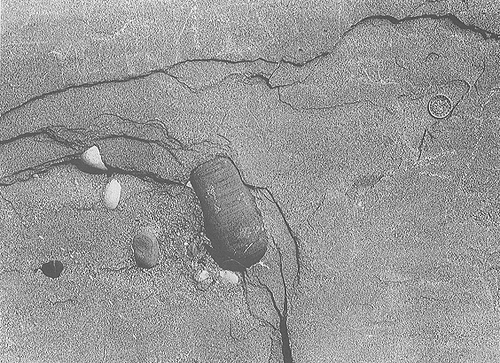
Pebble cluster
Plate 66

Pebble cluster
Plate 66
When a coarse particle remains anchored to the bottom and the current is not able to remove it, a shadow zone is created by its protrusion: boundary flow lines detach from the bottom at the summit of the obstacle, jump into the fluid as from a diving-board, and reattach farther on. Smaller particles can find a protection in the shadow zone, where turbulence and velocity are reduced, and come to a rest. In some cases, the jump (flow separation) occurs before the obstacle because it offers a sudden and strong resistance to flow (a wall effect), and a shadow zone is localized there, too. Depending on the size and the shape of the obstacle, various cases can occur: no shadow zones (or too small ones), presence of such a zone either before or behind the obstacle, or in both positions (compare with plate 82).
Pebble clusters are the signature of hydraulic shadow zones, even if the obstacles are later removed. The cluster seen in the picture is particularly evident because the pebbles are embedded in sand. When the whole bed is made of pebbles, one can recognize the clusters for their contrast in particle size or packing with the surrounding areas.
A further observation is possible here: it gives us a hint to the mechanisms operating in the bed load of a tractive current. The larger pebble has an elongate shape (prevalence of a axis over the other two), and is transversal to the paleoflow direction. This means that it rolled on the bottom. When similar particles are suspended, their long axes are aligned parallel to the flow.
Messinian sandstones and conglomerates of the Colombacci Formation, Pietrarubbia, northern Apennines.